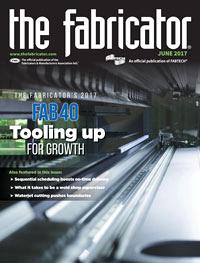President/CEO
- FMA
- The Fabricator
- FABTECH
- Canadian Metalworking
Categories
- Additive Manufacturing
- Aluminum Welding
- Arc Welding
- Assembly and Joining
- Automation and Robotics
- Bending and Forming
- Consumables
- Cutting and Weld Prep
- Electric Vehicles
- En Español
- Finishing
- Hydroforming
- Laser Cutting
- Laser Welding
- Machining
- Manufacturing Software
- Materials Handling
- Metals/Materials
- Oxyfuel Cutting
- Plasma Cutting
- Power Tools
- Punching and Other Holemaking
- Roll Forming
- Safety
- Sawing
- Shearing
- Shop Management
- Testing and Measuring
- Tube and Pipe Fabrication
- Tube and Pipe Production
- Waterjet Cutting
Industry Directory
Webcasts
Podcasts
FAB 40
Advertise
Subscribe
Account Login
Search
Check out the Section 232 testimonial lineup
Speakers heavily weighted toward the domestic steel industry
- By John Packard
- June 16, 2017
- Article
- Metals/Materials
U.S. Department of Commerce (DOC) Secretary Wilbur Ross will be a household name by early July 2017. The reason manufacturing companies, steel service centers, steel mills, and trading companies, as well as any other company associated with the steel industry, will care is that he has promised to have the Section 232 recommendation to President Trump by the end of June.
For fabricators of steel products, the outcome could be a real game-changer.
Officials from China, Russia, Turkey, Vietnam, South Korea, and to a less extent Taiwan must have had burning ears on May 24 after the bad-mouthing they got at the Section 232 hearing on steel. Of the 37 scheduled speakers, nine domestic companies and organizations and four foreign entities (Russia, China, Ukraine, and the European steel association Eurofer) spoke on behalf of allowing foreign steel without restrictions, other than antidumping and countervailing duty (AD/CVD) restrictions. The other 24 companies and organizations were there to support the steel industry and to call for restrictions against foreign steel products.
At the beginning of the hearing, Ross spoke about the question the DOC has been charged to answer: Is steel being imported into this country impairing our national and economic security? If the DOC finds foreign steel imports threaten our security, it will recommend appropriate action to the president.
Key questions Ross raised that need to be answered include:
- Does the problem rise to the level of crisis sufficient to warrant action beyond AD/CVD cases?
- If the president does take action, should it cover all steel from everywhere?
- What do we do with steel imports from NAFTA partners?
- Are all products covered?
- What kind of tariffs will be applied?
- Should some countries be excluded?
- Should tariffs be broadly applied or to groups of products?
Ross, in a response to Rep. Marcy Kaptur, D-Ohio, told the audience that he does not expect this review to take the 270 days as allowed under the guidelines. He said he will have the report to the president by the end of June 2017.
This falls right in line with the timeline provided by trade attorney Lewis Leibowitz in a recent article written for Steel Market Update (SMU). His expectation is for the president to make an announcement regarding steel and its impact on national security around the end of July of this year.
From SMU’s perspective, and from the perspective of many of those with whom we spoke after the hearing, the presentations were stacked against supporters who want to allow foreign steel into the U.S. market.
The main points being made by those supporting the Section 232 argument were:
- The need for a strong steel industry to ensure the country has what it needs for infrastructure, oil and gas drilling, movement of supply, the electrical grid, and defense-specific projects.
- A call for additional duties or quotas on foreign steel, with one speaker recommending using the year 2012 as the base year from which to assign quotas.
- Speakers pointed to the massive global overcapacity, which some put anywhere from 400 to 800 million metric tons.
- Government distorting policies resulting in predatory export pricing.
- Foreign steel does not have to grapple with the same environmental restrictions, wages, and taxes that exist in U.S. industry.
- Current trade remedies, such as additional duties, are not working to keep steel out of the U.S. market.
Pipe and Tube Industry as an Example
The pipe and tube industry was well-represented and used as an example of what happens to an industry, even with AD/CVD complaints, besieged by steel from other countries. Imports now represent more than 50 percent of the total U.S. market.
“In sum, to ask if pipe and tube is vital to our national security is not the right question. The question is really how our country could possibly be secure without it. Our economy and our military would grind to a screeching halt without a vibrant domestic tube industry. We employ tens of thousands of people, providing income levels far superior to the touted minimum wage victories. In addition, our industry consumes over 20 million tons of the flat-rolled steel produced in the United States, the largest single category,” said Barry Zekelman, president and CEO of Zekelman Industries, a pipe and tube manufacturing company, in his prepared remarks to the panel. “So, if we go out of business, the steel producers are not far behind.
“Imports have decimated our industry, resulting in the closure of a host of pipe and tube mills and throwing thousands out of work. In the first quarter of this year, imports in all pipe and tube categories exceeded 60 percent of consumption, with some categories reaching 70 percent and higher,” he continued. “It would be the epitome of folly to allow our nation to continue to permit imports to grow, putting U.S. producers out of business, and making our country vulnerable due to its reliance on foreign producers in China, Korea, Vietnam, Turkey, and elsewhere.”
A Warning About Unintended Consequences
The American Institute for International Steel (AIIS) speaker was attorney Gary Horlick, who spoke about the repercussions of the Section 232 cases in the past.
“The past history of this clause illustrates the extreme caution needed to avoid misuse for political reasons. It is frequently stated that the statute has only been used for import protection twice, both involving relatively minor uses involving crude oil in the 1970s. But this forgets the largest use of this statute, under a predecessor statute,” he said. “From 1959 to 1973, the U.S., for internal domestic political reasons, imposed quantitative restrictions on the import of crude oil. This had three very direct consequences:
- In the name of protecting our national security, the U.S. for those 12 years pumped out our own reserves, and in the end of the period, the U.S., for most of its history a major net oil exporter, had become a net importer of crude oil.
- During this period, U.S. downstream industry, as a direct result of the quotas, paid 50 to 100 percent more for its oil (used both as an input and as energy) than its foreign competitors, effectively giving a huge cost advantage to competitors in the newly reconstructed industries in Japan and Europe. At the end of the quotas, the U.S. ran a trade deficit in goods.
- The U.S. granted an exemption to the quotas to its close ally and neighbor, Canada. In 1959 the minister of national patrimony of Venezuela, then a very close U.S. ally, flew to Washington to ask for a similar exemption. This was refused, and Minister Alonso, instead of flying back to Caracas, flew directly to Riyadh and founded OPEC.”
Horlick went on to warn of what he felt would be a certainty—retaliation against U.S. exports. The first of two largest areas of concern would be military-related exports, such as planes and rockets, and the second would be agricultural products.
Most of the speakers supporting foreign steel were product-specific. For example, ADI Steel wanted a waiver on 0.010 to 0.012-in. G30 galvanized, and Steelscape wanted a waiver on hot-rolled. Meanwhile, the opposition focused on how the commercial sides of their businesses also are tied to the defense side. Without a strong commercial core, they argued, their businesses could not exist to produce the necessary products to support military and infrastructure applications.
The DOC panel asked only a few questions and gave no specific indications as to how they were leaning.
Steel Market Update will have a number of extremely qualified speakers at our seventh SMU Steel Summit Conference on Aug. 28-30. We have trade attorney Lewis Leibowitz, former International Trade Commission Chairman Daniel Pearson, Steel Manufacturers Association President Philip Bell, and William Gaskin, the president emeritus of the Precision Metalforming Association. They will be able to tackle the Section 232 questions as well as those associated with AD/CVD, circumvention (involving China and Vietnam), and the U.S. Steel Section 337 complaint.
For details about our Atlanta-based conference, please visit www.steelmarketupdate.com/events/steel-summit.
About the Author

John Packard
800-432-3475
John Packard is the founder and publisher of Steel Market Update, a steel industry newsletter and website dedicated to the flat-rolled steel industry in North America. He spent the first 31 years of his career selling flat-rolled steel products to the manufacturing and distribution communities.
subscribe now

The Fabricator is North America's leading magazine for the metal forming and fabricating industry. The magazine delivers the news, technical articles, and case histories that enable fabricators to do their jobs more efficiently. The Fabricator has served the industry since 1970.
start your free subscription- Stay connected from anywhere

Easily access valuable industry resources now with full access to the digital edition of The Fabricator.

Easily access valuable industry resources now with full access to the digital edition of The Welder.

Easily access valuable industry resources now with full access to the digital edition of The Tube and Pipe Journal.
- Podcasting
- Podcast:
- The Fabricator Podcast
- Published:
- 04/30/2024
- Running Time:
- 53:00
Seth Feldman of Iowa-based Wertzbaugher Services joins The Fabricator Podcast to offer his take as a Gen Zer...
- Industry Events
Pipe and Tube Conference
- May 21 - 22, 2024
- Omaha, NE
World-Class Roll Forming Workshop
- June 5 - 6, 2024
- Louisville, KY
Advanced Laser Application Workshop
- June 25 - 27, 2024
- Novi, MI
Precision Press Brake Certificate Course
- July 31 - August 1, 2024
- Elgin,
































